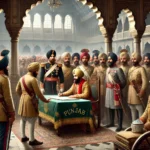PAK YATRA is a tour operator company providing tour services and facilitates Sikh community from different parts of the world.
History of Mahabat Khan Mosque
Background and Historical Significance:
The Mahabat Khan Mosque, also spelled Mohabbat Khan Mosque, stands as a testament to the rich architectural and cultural heritage of Peshawar, Pakistan. Constructed in the 17th century during the Mughal era, this mosque holds immense historical significance. It was built in 1630 by Nawab Mahabat Khan Kamboh, the Mughal governor of Peshawar at the time, and named in his honor. The mosque’s white marble façade, adorned with intricate designs, has become an iconic symbol of Peshawar’s architectural heritage.
Location:
Situated in Peshawar, Khyber Pakhtunkhwa Province, Pakistan, the Mahabat Khan Mosque occupies a central position within the city. Its strategic location within the old city, atop the highest point, underscores its prominence in the urban landscape.
Latitude and Longitude:
Latitude: 34.010000000
Longitude: 71.573400000
Historical Evolution:
The construction of the Mahabat Khan Mosque took place between 1660 and 1670, under the patronage of the Mughal rulers. The mosque was meticulously designed to embody the grandeur of Mughal architecture while incorporating elements of Islamic artistry. Over the centuries, the mosque has witnessed various historical events, including the turbulent times of Sikh rule and the Soviet invasion of Afghanistan. It served as a gathering place for refugee tribal elders during the Soviet-Afghan War, highlighting its role as a center for community unity and resilience.
Preservation Efforts:
Despite facing challenges from political upheavals and environmental factors, the Mahabat Khan Mosque has undergone several preservation and restoration efforts to safeguard its architectural integrity. In recent years, the Government of Khyber Pakhtunkhwa has allocated significant resources towards the conservation and maintenance of this historic landmark. Conservation projects have focused on restoring the mosque’s minarets, domes, ablution areas, and interior decorations to their original glory. Efforts have also been made to address encroachments and maintain the surrounding area to enhance the visitor experience.
Architectural Marvel:
The Mahabat Khan Mosque is renowned for its exquisite architectural design, blending Mughal and Islamic influences seamlessly. The mosque’s exterior features a stunning white marble façade adorned with intricate floral motifs and Quranic calligraphy. Its central courtyard, encompassing an ablution pool and surrounded by a row of rooms, reflects the functional layout typical of Mughal-era mosques. The prayer hall, flanked by two majestic minarets, showcases elegant red frescoes and geometric patterns on its ceiling. The meticulous craftsmanship displayed in the construction of the mosque’s arches, portals, and domes attests to the mastery of Mughal architects and artisans.
In conclusion, the Mahabat Khan Mosque stands as a living testament to Peshawar’s rich cultural heritage and architectural prowess. Its enduring legacy as a place of worship, community gathering, and historical significance continues to resonate with visitors and locals alike, reinforcing its status as a cherished symbol of Pakistan’s cultural identity.
Historical Evolution:
The Mahabat Khan Mosque has a rich historical evolution that spans over four centuries, reflecting the dynamic cultural and political landscape of Peshawar, Pakistan. Constructed between 1660 and 1670 during the Mughal era, the mosque was commissioned by Nawab Mahabat Khan Kamboh, the Mughal governor of Peshawar. Its construction marked a significant period of architectural development in the region, characterized by the fusion of Mughal and Islamic design elements.
Over the centuries, the mosque has endured various historical events, including periods of political upheaval and cultural transformation. During the Sikh rule, the minarets of the Mahabat Khan Mosque were infamously utilized for hanging prisoners, highlighting the mosque’s involvement in the region’s socio-political dynamics.
The Soviet invasion of Afghanistan in the late 20th century further underscored the mosque’s historical significance as a place of refuge and unity for Afghan tribal elders. Amidst these tumultuous times, the Mahabat Khan Mosque remained a steadfast symbol of resilience and communal solidarity, exemplifying its enduring legacy in the face of adversity.
Background:
The Mahabat Khan Mosque stands as a testament to the architectural brilliance of the Mughal period in South Asia. Its construction was initiated by Nawab Mahabat Khan Kamboh, a prominent figure in the Mughal administration, who sought to leave a lasting legacy in the city of Peshawar. The mosque’s strategic location atop the highest point in the old city reflects the Mughals’ meticulous urban planning and architectural vision.
Inspired by Mughal architectural traditions, the Mahabat Khan Mosque embodies the fusion of Persian, Central Asian, and Islamic design elements, showcasing intricate carvings, geometric patterns, and Quranic calligraphy. Its construction epitomizes the Mughal rulers’ patronage of art and culture, as they sought to establish Peshawar as a center of intellectual and religious excellence.
Historical Significance:
The Mahabat Khan Mosque holds immense historical significance as a cultural and architectural landmark in Peshawar, Pakistan. As one of the finest examples of Mughal-era architecture in the region, the mosque serves as a symbol of the city’s rich cultural heritage and religious diversity.
Throughout its history, the Mahabat Khan Mosque has served as a place of worship, community gathering, and socio-political discourse. It has witnessed pivotal moments in the region’s history, from the reign of Mughal emperors to the tumultuous periods of Sikh rule and the Soviet-Afghan War.
Beyond its architectural splendor, the mosque remains a beacon of resilience and unity for the people of Peshawar, reflecting the enduring spirit of the community in the face of adversity. Its preservation and conservation efforts underscore its cultural significance as a tangible link to Pakistan’s historical and architectural legacy, ensuring that future generations can appreciate its timeless beauty and historical resonance.




